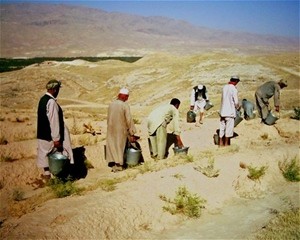
Pistachio reforestation activities have created jobs for rural villagers. Communities are working together towards longer-term sustainable development.
Afghan Conservation Corps
Pistachio harvest increases with formation of Forest Management Committees
“The 2006 pistachio harvest of the villagers in Shareek Yaar estimated a 65% increase in revenue due to proper and timely harvesting and vigilance in protecting the forest from livestock grazing,” says Haji Abdul Samad, head of the Forest Management Committee.
17 FEBRUARY 2007 | SAMANGAN PROVINCE
CHALLENGE The wild pistachio woodlands of Afghanistan have declined rapidly over the past 30 years, from 40 to 100 trees per hectare to the current estimate of 20 to 40 trees per hectare due primarily to cutting of trees, over grazing, and damage to trees through uncontrolled harvesting of the pistachio nuts. The natural pistachio woodlands have significant environmental and economic value to Afghans.
INITIATIVE The people living in the Shareek Yaat and Madrasa Villages of Samangan Province understand the importance of protecting and conserving the woodlands to their livelihood. Earlier this year, the elders of these communities established Forest Management Committees (FMCs) with guidance from the Afghan Conservation Corps (ACC) and the Ministry of Agriculture and Irrigation (MAI).
The Forest Management Committee’s protection and management activities include stopping the construction of new residences within the woodlands, drafting a forest protection plan that protects 1,500 hectares of woodlands, and designating 10 full-time community protection guards to protect the pistachio woodlands from damaging activities. To control improper early pistachio harvesting, they have worked with the police, local and central government agricultural officials to establish specific dates in August each year for pistachio nut harvesting.
“The 2006 pistachio harvest of the villagers in Shareek Yaar recorded an estimated 65% increase in revenue due to proper and timely harvesting and vigilance of the Committee in protecting the forest from livestock grazing,” according to Haji Abdul Samad, head of the FMC.
RESULTS Pistachio woodlands that were degraded and of declining value to villagers in part of Samangan province are now being protected and restored, yielding greater income after just one year. Local communities have established 345,000 Pistacia vera seedlings through direct seeding of pits in 518,000 meters of terracing covering 186 hectares of pistachio woodlands in 7 provinces. These reforestation activities benefited thousands of Afghans and created over 160,000 labor days for almost 8,000 rural villagers surrounding the forests. The reforestation activities have served to strengthen Community Development Councils, local democratically elected village governance systems, and provided a concrete opportunity for the village to work together towards longer-term sustainable development through the protection of their valuable pistachio.
USAID provided funding for the project which, with technical assistance from the U.S. Department of Agriculture (USDA), was implemented by Afghan Conservation Corps, a project of the Afghan government and the United Nations Office for Project Services (UNOPS).







Comment
Make a general inquiry or suggest an improvement.